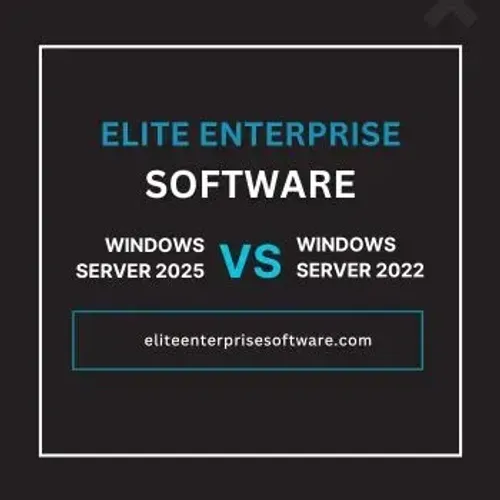Windows Server 2025 RDS CAL vs. 2022

Microsoft recently unveiled its new Windows Server 2025, and it’s stirring excitement within the tech community. As businesses look to improve remote work capabilities, it’s important to understand what Windows Server 2025 brings to the table, especially in comparison to the older 2022 model. In this blog, we’ll explore the key differences between Windows Server 2025 and 2022 RDS CALs, examining new features, security upgrades, performance, and licensing options, to help you determine whether upgrading to the latest version is the right move for your business.
What Are Windows Server RDS CALs?
Remote Desktop Services (RDS) Client Access Licenses (CALs) allow businesses to provide remote desktop access to users. These CALs are essential for enabling employees to work from any location, making it a key tool for supporting a flexible, distributed workforce. With a reliable internet connection, users can access a Windows server environment as if they were physically in the office, boosting productivity and collaboration.
For businesses using Windows Server RDS, selecting the right CAL is crucial. The licensing method, known as CALs, is essential for enjoying all the features of remote desktop services in 2024.
Overview of Windows Server 2022 RDS CAL
Windows Server 2022 RDS CAL is offered in three editions: Essentials, Standard, and Datacenter. Each edition is designed to meet the needs of businesses of varying sizes, offering remote work capabilities suitable for small to large-scale enterprises. This version of Windows Server is highly compatible with earlier releases, but users who want access to the features of Windows Server 2025 will need to upgrade their RDS CALs, as they are not supported by the 2022 version.
What’s New in Windows Server 2025 RDS CAL?
Windows Server 2025 introduces a range of advancements over the 2022 version. With an eye toward supporting heavy workloads and virtualized environments, the new release focuses on improved performance, enhanced security, and more seamless cloud integration.
Key new features of Windows Server 2025 include:
Improved Security: With advanced threat detection, multi-factor authentication (MFA), and improved encryption protocols, Windows Server 2025 prioritizes the safety of your data.
Cloud Integration: The 2025 version offers seamless cloud integration, enabling better hybrid work environments.
Enhanced Virtual Desktop Infrastructure (VDI) Support: It supports more complex and demanding virtual desktop infrastructures, making it a more powerful option for businesses relying on virtualized workspaces.
Performance Optimization: Windows Server 2025 is built to handle heavy remote workloads more efficiently, resulting in faster and more reliable user experiences.
Performance Comparison: Windows Server 2025 vs. 2022 RDS CAL
When comparing Windows Server 2025 to the 2022 version, the latter still offers reliable performance, but the 2025 model takes it a step further with advanced optimizations. Windows Server 2025 excels in high-demand environments and ensures smoother performance, even with more users and virtualized settings.
The 2025 version is designed with performance in mind, allowing businesses to scale and adapt to evolving needs without sacrificing reliability or speed. The ability to handle higher volumes of remote traffic, along with better user experience features, makes the Windows Server 2025 RDS CAL an attractive upgrade.
Security Features in Windows Server 2025 RDS CAL
One of the standout improvements in Windows Server 2025 is its robust security enhancements, making it a strong contender for businesses looking to protect sensitive information.
Key security upgrades in Windows Server 2025:
Multi-Factor Authentication (MFA): To ensure a higher level of protection, Windows Server 2025 incorporates multi-factor authentication. After entering your username and password, an additional authentication method—like a one-time password or biometric data—is required to access the system.
Improved Encryption Standards: The 2025 version offers stronger encryption algorithms for better protection of confidential data and machine account passwords.
Advanced Threat Protection: Powered by AI, the new system uses behavior analytics and Azure Defender to detect and mitigate potential security threats before they cause damage.
Licensing Changes: Windows Server 2025 vs. 2022 RDS CAL
Windows Server 2025 continues the licensing model introduced with Windows Server 2022, with a few key differences that provide greater flexibility:
Virtual Machine Licensing: With Windows Server 2025, businesses can license at the virtual machine (VM) level, which reduces costs by only requiring licensing for virtual machines and not the entire physical server. This model is especially beneficial for heavily virtualized environments.
Hot Patching Across Editions: Previously, the hotpatching feature was available only with the Azure Edition of Windows Server 2022. However, with Windows Server 2025, hot patching is available across all editions with Software Assurance.
Compatibility and Migration
Before upgrading to Windows Server 2025, ensure that your current systems meet the new hardware and software requirements. Migration from Windows Server 2022 to 2025 is straightforward but may require certain updates to your infrastructure.
Cost Analysis: Is It Worth Upgrading?
While upgrading to Windows Server 2025 may come with higher upfront costs, the benefits in terms of improved performance, enhanced security, and flexibility make it a sound long-term investment. For growing businesses, the ability to scale efficiently and secure a remote workforce makes the upgrade worthwhile. Additionally, the reduction in downtime and improved security measures could save businesses significantly in the long run.
When to Choose Windows Server 2025 RDS CAL Over 2022
Windows Server 2025 RDS CALs are a better choice for businesses with large remote workforces, high-security needs, or those using heavily virtualized environments. The enhanced performance, security measures, and cloud compatibility make it ideal for modern business needs.
Conclusion: Why Upgrade to Windows Server 2025?
With its improved performance, enhanced security features, and flexibility, Windows Server 2025 RDS CALs provide a more robust solution for businesses looking to support remote work and future-proof their IT infrastructure. The new capabilities, including AI-powered threat detection, better VDI support, and more streamlined cloud integration, make it a valuable upgrade from Windows Server 2022.
If your business relies on remote work and needs a more powerful, secure, and scalable solution, upgrading to Windows Server 2022 RDS 5 Device CAL could be the perfect choice.

